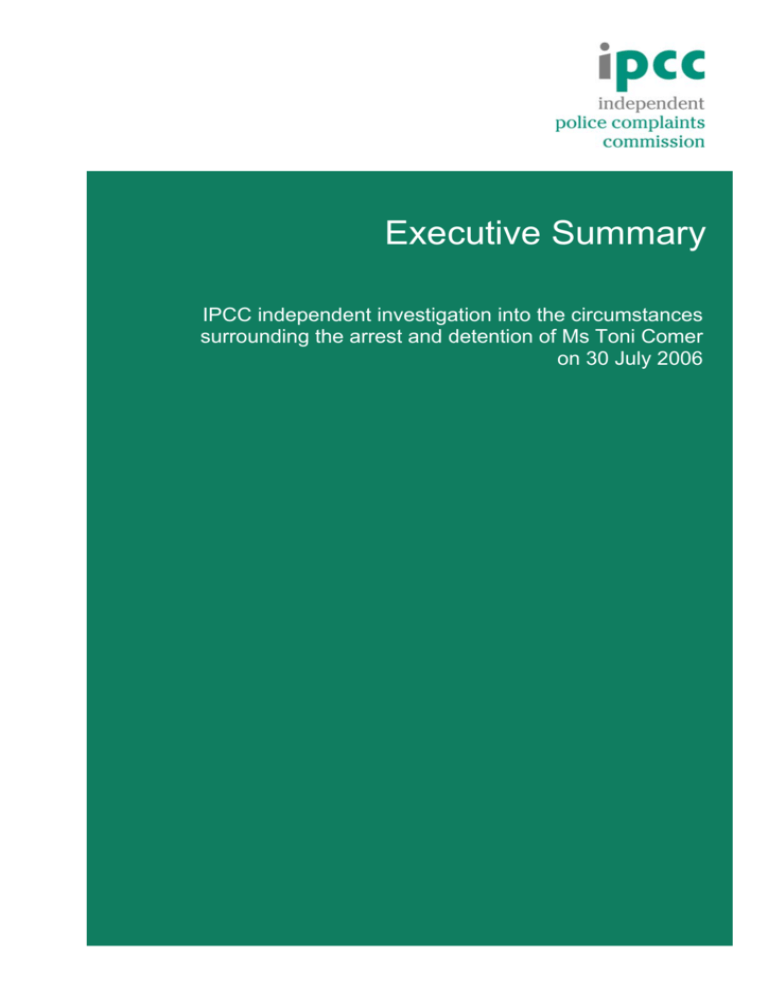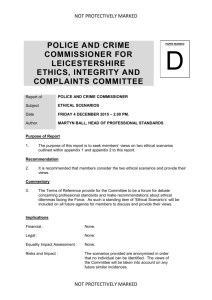Ms Toni Comer executive summary
advertisement

Executive Summary IPCC independent investigation into the circumstances surrounding the arrest and detention of Ms Toni Comer on 30 July 2006 <NOT PROTECTIVELY MARKED> Overview of Investigation On 7 March 2007 the BBC Newsnight programme aired CCTV footage of the arrest of Ms Toni Comer by South Yorkshire Police officers outside the Niche nightclub in Sheffield. The incident, which had taken place on 30 July 2006, included the apparent use of force by at least one officer to facilitate the arrest. The incident prompted extensive media coverage and the matter was referred to the Independent Police Complaints Commission on 8 March 2007. IPCC Commissioner Nicholas Long decided that, due to the high level of public interest and the potential seriousness of allegations against the officers involved, an independent investigation should be conducted. Specific Terms of Reference for Investigation The investigation addressed: 1. Whether the use of force by police officers was proportionate and reasonable in the circumstances; 2. Whether Ms Comer was treated with the appropriate level of respect and dignity during her arrest and detention; 3. Whether or not the review officer fulfilled his / her obligations under Code C of the Codes of Practice, paragraph 15, Reviews and extensions of detention; 4. Whether South Yorkshire Police dealt with the complaint regarding the arrest and detention of Ms Comer, in an appropriate and professional manner; Toni Comer Executive Summary FINAL <NOT PROTECTIVELY MARKED> 2 <NOT PROTECTIVELY MARKED> 5. Whether South Yorkshire police dealings with Ms Comer, on and since the 30th July 2006, were negatively influenced by her ethnicity and/or race. The investigation was mindful of the high level of public interest and potential third party perception that there has been a racial element in the treatment of Ms Comer; Collation of Evidence IPCC investigators had access to approximately four minutes of CCTV footage covering the incident. This footage came from three different cameras located in the car park area of the Niche nightclub. This footage covered much more of the incident than the edited version obtained by The Guardian newspaper and broadcast by the BBC, which lasted less than 30 seconds and was from one camera position. A number of techniques were used on the CCTV footage to enhance the images. IPCC investigators also obtained accounts from police officers and nightclub security staff who were present in the car park during Ms Comer's arrest and consulted with independent experts in the field of police restraint techniques and epilepsy. Overview of Investigation Findings Events at Niche nightclub The investigation determined that in the early hours of 30 July 2006 Ms Comer was ejected from the Niche nightclub in Sheffield as a result of her aggressive behaviour. Ms Comer returned to the nightclub car park on two occasions and caused criminal damage to vehicles. Toni Comer Executive Summary FINAL <NOT PROTECTIVELY MARKED> 3 <NOT PROTECTIVELY MARKED> On the first occasion Ms Comer was with a male companion and both were chased away from the area by security staff from the nightclub. On the second occasion Ms Comer had changed her clothes and returned to the car park wearing a dark hooded top. She is seen on CCTV footage running up a fire escape staircase at the rear of the nightclub after throwing some items around the car park. A police constable, who was in the vicinity of the nightclub car park on a specific operation attempted to detain Ms Comer. The officer pursued Ms Comer to the top of a fire escape staircase. The male companion who had been with Ms Comer earlier then appears on the footage and attempts to intervene by pulling Ms Comer away from the officer. A member of Niche's security staff challenges the man and chases him away from the car park. Ms Comer then attempts to escape from the police constable by moving down the staircase. Ms Comer appears to strike the officer on the head with her right hand and knocks his hat off. Ms Comer then loses her balance and falls, dragging the officer down with her. A struggle then ensues on the floor with the officer attempting to restrain Ms Comer. A member of the nightclub's security staff attempts to help at one point by holding Ms Comer's legs. The struggle continues and the officer strikes Ms Comer five times. The officer states the blows were delivered to Ms Comer's arm using the heel of his hand in an attempt to gain compliance so that he could apply handcuffs. Despite enhancement of the CCTV footage it is impossible to say with certainty where the blows landed. However there is no evidence to contradict the officer's version of events. Nor is their evidence of Ms Comer receiving injuries that would contradict the officer's version of events. Despite the officer's actions he states he was only able to apply handcuffs to one arm. A second officer intervened and is seen to place his foot onto Ms Toni Comer Executive Summary FINAL <NOT PROTECTIVELY MARKED> 4 <NOT PROTECTIVELY MARKED> Comer. The officer openly admitted in interview that he used his foot to apply pressure to Ms Comer's arm to gain compliance. The CCTV footage cannot give proof of where the foot was placed. However the footage does support the assertion that the foot was placed on Ms Comer and there is no evidence of the officer stamping or kicking Ms Comer. This action assisted the officers in applying handcuffs to both of Ms Comer's hands. Ms Comer was then brought to a standing position and escorted by two officers to a police van. Ms Comer's trousers fell down en route to the van. Ms Comer has no recollection of the events and her complaint was largely based on the CCTV footage. Ms Comer believed she had suffered an epileptic seizure and this accounted for her behaviour prior to and during the incident. The witness statements of the officers and nightclub staff corresponded with the events seen on the CCTV footage. Events in Custody Ms Comer was taken to Bridge Street Police Station in Sheffield. Her custody was authorised at 2:50am. She was interviewed and made no complaint about the manner of her arrest. Slight bruising was noted around Ms Comer's arms. No other injuries were evident. A review of Ms Comer's detention took place at 9:50am. The Police and Criminal Evidence Act 1984 requires reviews to take place at six-hour intervals. If they are postponed then specific reasons must be given. Ms Comer was bailed and released from custody. Toni Comer Executive Summary FINAL <NOT PROTECTIVELY MARKED> 5 <NOT PROTECTIVELY MARKED> Post Custody Matters The licensee of the Niche nightclub made South Yorkshire Police aware of the existence of the CCTV footage covering the arrest on 31 July 2006. As a result of viewing this footage a letter was written to Ms Comer dated 7 August 2006 advising that there may be police conduct issues relating to her arrest and giving her the opportunity to lodge an official complaint. The letter also requested permission to access her hospital records and alluded to the fact that she may have received injuries. Ms Comer did not lodge a complaint or take up the opportunity given to discuss the matter further, but did give South Yorkshire Police permission to access her medical records. These showed that Ms Comer had not attended hospital with injuries that may have resulted from her arrest. Ms Comer lodged a formal complaint with South Yorkshire Police on 18 October 2006 after she had been shown a copy of the CCTV footage. South Yorkshire Police determined the matter as sub-judice due to the ongoing criminal case relating to the criminal damage charge. Expert Analysis Police Restraint Techniques An expert in police restraint techniques was provided with a copy of the enhanced CCTV footage, relevant statements and copies of the transcripts of the officers’ interviews to determine whether the actions of the officers involved in the restraint and arrest of Ms Comer, reflected accepted police best practice in the field of officer safety and the Conflict Management Model. In his opinion, the actions of the officers were in line with their training. Toni Comer Executive Summary FINAL <NOT PROTECTIVELY MARKED> 6 <NOT PROTECTIVELY MARKED> Epilepsy A consultant neurologist, who is a specialist in the field of epilepsy, was asked to consider Ms Comer’s demeanour and behaviour, as seen on the CCTV footage, with reference to typical symptoms and affects of an epileptic seizure. The opinion was sought to assist in the consideration of how the officers would have been expected to assess Ms Comer. All the officers involved displayed knowledge of epilepsy and its manifestations, none of those present made a judgement that they were dealing with someone exhibiting the signs of an epileptic seizure. The consultant neurologist reported that, in his opinion, Ms Comer's appearance and actions were not consistent with a person suffering from the effects of a recent epileptic seizure. Key Conclusions Assault Allegations The two officers accused of assaulting Ms Comer gave full descriptions of their actions and were adamant that they were proportionate, legal and necessary in the situation they faced. There is no evidence to contradict the officers' accounts. Ms Comer had no recorded injuries that could contradict the accounts of the two officers. Therefore the evidence collated during the investigation did not substantiate the allegation that the officers used unnecessary force. The investigation report was submitted to the Crown Prosecution Service for their consideration of the assault allegation. The CPS determined that there was insufficient evidence to warrant any criminal charges being brought against the officers. Toni Comer Executive Summary FINAL <NOT PROTECTIVELY MARKED> 7 <NOT PROTECTIVELY MARKED> As there was no evidence to substantiate the allegation of assault, it followed that there was no evidence to substantiate the complaint that other officers in attendance did nothing to stop the alleged assault. Allegation that officers failed to protect Ms Comer's modesty The two officers who escorted Ms Comer to the waiting police van were aware that her trousers had fallen down. However, given Ms Comer's aggressive behaviour and attempts to resist arrest, the officers believed it was necessary to transport her to the van quickly. Ms Comer's trousers were pulled up once she reached the police van. The investigation concluded that the officers' actions were appropriate given the circumstances. Detention Ms Comer is correct in stating that her detention should have been reviewed an hour earlier than it was. The Police and Criminal Evidence Act 1984 allows for a review to be postponed if, having regard to the circumstances, it 'is not practicable' to have it at the specified time. The grounds for such a postponement must be recorded in the custody record. No such record exists to explain why the review of Ms Comer's detention took place an hour later than required. The officers in attendance have no recollection of the reason for the delay. Ms Comer's assertion that she was unlawfully detained at this point may be correct, if it is considered that the legal power to detain her did not exist at that time. South Yorkshire Police will address the issues of prompt reviews of detention (in accordance with legislation) through the training and awareness of the Toni Comer Executive Summary FINAL <NOT PROTECTIVELY MARKED> 8 <NOT PROTECTIVELY MARKED> appropriate staff. Racism Neither Ms Comer nor her family have ever suggested to the IPCC that she was treated differently by South Yorkshire Police during this incident due to her ethnicity. The IPCC was fully aware that there was a third party perception that the alleged actions of the officers may have been fuelled by Ms Comer's ethnicity. The IPCC found no evidence to support such allegations. Specific Recommendations 1. The investigation team determined that South Yorkshire Police were incorrect to treat Ms Comer's complaint as sub-judice. Once the CPS had determined that the only offences being considered against Ms Comer were criminal damage then the investigation into the allegations relating to the restraint and detention could have progressed. This matter has been raised with South Yorkshire Police. 2. An officer specifically referenced in Ms Comer's complaint of 18 October 2006 was not served with a Regulation 9 notice on 15 March 2007. A Regulation 9 notice formally advises an officer that he is under investigation. The notice safeguards the officer's rights and should be issued as soon as practicable after it becomes clear that an allegation involving the conduct of an identifiable officer is to be included in an investigation. The notice should have been served by South Yorkshire Police at a much earlier stage as the delay was unfair on the officer. Independent Police Complaints Commission 9 January 2008 Toni Comer Executive Summary FINAL <NOT PROTECTIVELY MARKED> 9 <NOT PROTECTIVELY MARKED> Toni Comer Executive Summary FINAL <NOT PROTECTIVELY MARKED> 10








